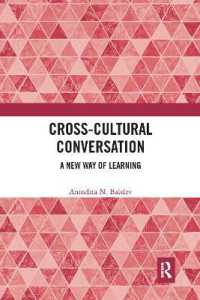基本説明
This seminal work, considered a timeless classic in Translation Studies, is now available in English. Having drawn on adjacent disciplines, the methodology of Czech functional sociosemiotic structuralism and the state-of-the art in the West, Levy synthesized his findings and experience in the field presenting them in a reader-friendly book.
Full Description
Jiří Levý's seminal work, The Art of Translation, considered a timeless classic in Translation Studies, is now available in English. Having drawn on adjacent disciplines, the methodology of Czech functional sociosemiotic structuralism and the state-of-the art in the West, Levý synthesized his findings and experience in the field presenting them in a reader-friendly book, which combines the approaches of a theoretician, systemic analyst, historian, critic, teacher, practitioner and populariser. Although focused on literary translation from theoretical, descriptive and historical perspectives, it presents a conceptualization of a general theory, addressing a number of issues discussed today. The 'practical' mission of the book as a theory extending to practice is based on the same historical-dialectic affinity of methods, norms, functions and values, accounting for the translator's agency and other contextual agents involved in the communication process. The book will be useful to translators, researchers, students and teachers in Translation and Literary Studies.
Contents
1. Introduction to the second edition (1983); 2. Editor's introduction to the English edition; 3. Translator's introduction to the English edition; 4. Part I; 5. Chapter 1. Translation theory: The state of the art; 6. Chapter 2. Translation as a process; 7. Chapter 3. Translation aesthetics; 8. Chapter 4. On the poetics of translation; 9. Chapter 5. Drama translation; 10. Chapter 6. Translation in literary studies; 11. Part II; 12. Chapter 1. Original verse and translated verse; 13. Chapter 2. Translating from non-cognate versification systems; 14. Chapter 3. Translating from cognate versification systems; 15. Chapter 4. Notes on the comparative morphology of verse; 16. Chapter 5. Integrating style and thought; 17. References; 18. Index








